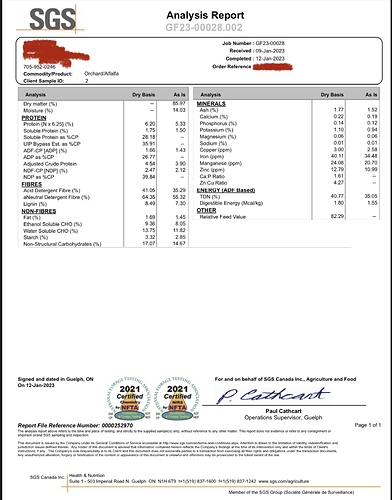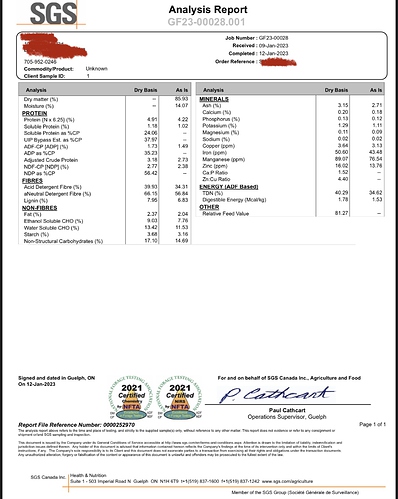Heavy hitters:
Protein (total protein or crude protein/CP): above 8% is usually considered pretty good, depending on what you are feeding. If you are dealing with growing, breeding, or heavily working animals, ideally you want something in the double digits. A lot of unfertilized hay will be below 8%. All those other protein numbers you see are comparing the amount of protein to the amount of fiber and looking at different fractions of protein.
ADF and NDF: these are your fiber components. ADF is acid detergent fiber; this is basically the non-nutritious part of the hay. You want it below 45%. NDF is neutral detergent fiber, mainly the cell walls of the plant. The insoluble “bulk” if you will. Below 65% is generally your target. Both these numbers climb when hay is over mature or in “stemmy” hay.
NSC: if you don’t have seriously metabolic horses, NSC or nonstructural carbohydrates is enough of a snapshot of the sugars and starches. Most horse hay is somewhere in the teens. 20% and up is notably high (but not uncommon). If you have metabolic or easy keeping horses, you want it to be around 10%.
Ca:P ratio: This compares the amount of calcium to phosphorus. You absolutely want to see a number over 1; if it’s below 1 you need to develop a plan for supplemental ca. If it’s between 1-3, you are generally good. Sometimes it’s very high, like 4 or up, in which case you may need supplemental P or to remove other Ca sources.
Other stuff is good to know, but if you look at the protein, fibers, and know the sugars and Ca:P ratios aren’t funky, you get a fair assessment.
A few other points:
Hay analyses don’t tell you how it was baled or handled; the only clue you might get is moisture, which should be in the teens. A high moisture indicates it wasn’t cured properly, BUT, mold can still grow on pretty much any hay.
Most people don’t do hay analyses and their horses survive just fine, because horse hays fall into these ranges frequently (but not always).
Horses don’t read hay analyses. So above all, it’s more important that they are eating it readily. (The one exception would be metabolic horses who need that low NSC).



 You might find it beneficial to supplement your horse with a little extra protein while eating hay
You might find it beneficial to supplement your horse with a little extra protein while eating hay  Proximity wasn’t the question, it was about whether there was a drought, as that’s all I could find/think of that could cause this low quality of hay
Proximity wasn’t the question, it was about whether there was a drought, as that’s all I could find/think of that could cause this low quality of hay
 I’m just never sure which Americans have a clue where different parts of Canada are, I forgot you aren’t one of them.
I’m just never sure which Americans have a clue where different parts of Canada are, I forgot you aren’t one of them.  Ontario had a good growing season this year, thank the powers that be.
Ontario had a good growing season this year, thank the powers that be.